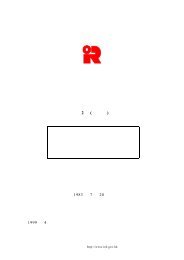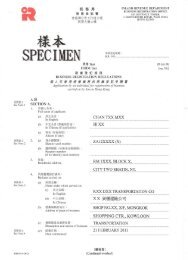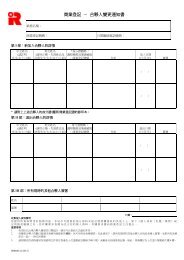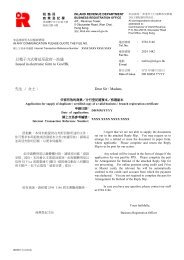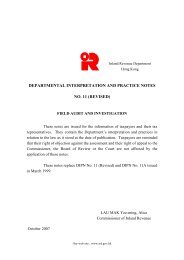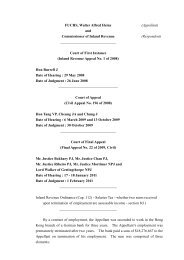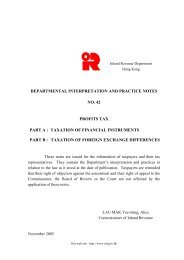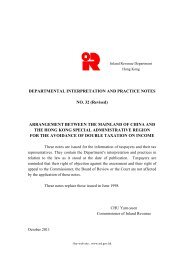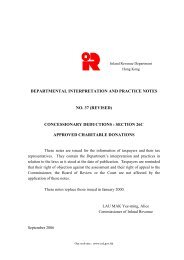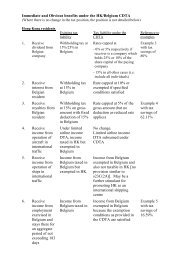A guide to Profits Tax for unincorporated businesses (2)
A guide to Profits Tax for unincorporated businesses (2)
A guide to Profits Tax for unincorporated businesses (2)
Create successful ePaper yourself
Turn your PDF publications into a flip-book with our unique Google optimized e-Paper software.
ForewordThis <strong>guide</strong> will help answer some of the questions that owners of small<strong>unincorporated</strong> <strong>businesses</strong> may have concerning the treatment of businessincome and expense items under <strong>Profits</strong> <strong>Tax</strong>.To keep it simple and easy <strong>to</strong> understand, this leaflet does not <strong>to</strong>uch on thequestion of source of profits.To know more about the tax rules, you have <strong>to</strong> refer <strong>to</strong> the Inland RevenueOrdinance (“IRO”) (Cap. 112) and its subsidiary legislations.Common questions and answersQ1If not every receipt from my business is taxable, which is taxable andwhich is not?AnswerGeneral RuleReceipts arising from day <strong>to</strong> day operations, e.g. sales of goods andprovision of services, are normally your operating income andtaxable.Proceeds from the sales of fixed/capital assets are capital receiptsand are usually non-taxable.Various income closely connected with your business operations arealso taxable, including –♦ rental income received from sub-letting part of yourbusiness premises;♦♦rebates received from trade associates; andthe <strong>for</strong>feiture of trade deposits or compensation moneysfrom cus<strong>to</strong>mers <strong>for</strong> the cancellation of ordinary businesscontracts.Sale proceeds arising from the sale of your business entity as agoing concern or of your fixed assets are normally of capital natureand non-taxable. You should however keep in mind the specificprovisions in the IRO which relate <strong>to</strong> the treatment of s<strong>to</strong>ck andmachinery and plant under such circumstances. (Seek advice froma practising accountant, if required.)1
schemes or MPF-exempted ORSO schemes (but the deductionis limited <strong>to</strong> 15% of the <strong>to</strong>tal emoluments of the employee <strong>for</strong>the period <strong>to</strong> which the payments relate);♦ MPF manda<strong>to</strong>ry contributions as a self-employed person <strong>for</strong>the sole proprie<strong>to</strong>r or partner, not exceeding the amountprescribed in the Inland Revenue Ordinance;♦ severance or long service payments paid at termination ofemployments;♦ interest and other expenses including legal fees on moneyborrowed <strong>for</strong> normal business operations (such as <strong>for</strong> thepurchase of s<strong>to</strong>ck) under specified conditions, e.g. the moneyis borrowed from a financial institution and the borrowing issecured by a mortgage of property, say, property owned by theproprie<strong>to</strong>r and/or the spouse;♦ bad or doubtful debts (i.e., sales duly recognized as yourturnover but <strong>for</strong> which you cannot collect payments fromcus<strong>to</strong>mers);♦ repairing costs <strong>for</strong> articles, premises, machinery and plant usedin producing profits (other than the cost of improvements);♦ the replacement costs of implements and utensils used inproducing profits (no depreciation allowance would beallowed in respect of the same items); and♦ approved charitable donations of not less than $100, but notexceeding 35% (25% <strong>for</strong> years of assessment 2006/07 and2007/08) of the adjusted assessable profits.Q3Are there deductions by way of tax incentives?Answer Yes, some of these deductions are listed below –♦ specified expenditures on copyrights, registered designs orregistered trade marks;♦ capital expenditures on environmental protection facilities;3
♦ 100% write-off of cost in the year of purchase of a “prescribedfixed asset”, which includes• machinery or plant used specifically and directly in anymanufacturing process,• computer hardware (other than that which is an integralpart of any machinery or plant), and• computer software and computer systems;but does not include any leased item or item acquired underhire-purchase terms;♦ capital expenditures incurred on the renovation orrefurbishment of buildings (other than domestic buildings) by 5equal deductions over 5 successive years of assessment;♦ industrial building allowance <strong>for</strong> industrial buildings andstructures; and♦ commercial building allowance <strong>for</strong> commercial buildings andstructures.Q4Which expense/outgoing is not deductible from the assessableprofits?Answer Expenses not deductible include (this is not an exhaustive list) –Domestic and private expensesExamples♦ messing and meals, medical expenses, insurance premiums,birthday celebration expenses <strong>for</strong> the sole proprie<strong>to</strong>r/partnersand/or their family members, etc.;♦ private share of utilities e.g. rates, electricity, water if thepremises is used <strong>for</strong> both business and residential purposes;♦ private share of mo<strong>to</strong>r vehicles expenses <strong>for</strong> vehicles used <strong>for</strong>both private and business purpose; and4
♦ costs of travelling between residence and place of business andoverseas travelling taken not <strong>for</strong> business purpose.Payments <strong>to</strong> sole proprie<strong>to</strong>r/partners and/or the spouseincluding:♦ salaries/remuneration;♦ interest on capital/loans;♦ rentals <strong>for</strong> business premises;♦ drawings from business; and♦ withdrawal of capital.Capital expenditures or lossesExamples♦ the cost of acquiring fixed assets such as plant and machinery,except those prescribed fixed assets as set out in the answer <strong>to</strong>Question 3;♦ the costs of acquiring the business premises including therelated stamp duty and legal fees;♦ the costs of any improvements <strong>to</strong> business premises;♦ loss of capital; and♦ loss on disposal of fixed assets.Certain contributions <strong>to</strong> retirement schemes including:♦ manda<strong>to</strong>ry MPF contributions <strong>for</strong> proprie<strong>to</strong>rs/partners in excessof the amount prescribed in the Inland Revenue Ordinance;♦ voluntary MPF contributions <strong>for</strong> proprie<strong>to</strong>r/partners; and♦ any MPF contributions <strong>for</strong> proprie<strong>to</strong>r’s/partner’s spouse.5
Business losses recoverable under an insurance policy orcontract of indemnity<strong>Tax</strong>es paid under the IRO, except Salaries <strong>Tax</strong> paid in respec<strong>to</strong>f employees’ remunerationSum expended not <strong>for</strong> producing assessable profitsExamples♦ penalties/fines <strong>for</strong> breaking the laws;♦ entertainment expenses not expended <strong>for</strong> business purpose; and♦ rent or expenses relating <strong>to</strong> premises not occupied <strong>for</strong> thepurpose of producing assessable profits.Q5I bought two machines <strong>for</strong> $200,000 and a second-hand lorry <strong>for</strong>$50,000. The purchase costs are capital expenditure and cannot bededucted from my assessable profits. Is there any relief that I canclaim?Answer You can claim <strong>to</strong> deduct depreciation allowances. Please refer <strong>to</strong>the summary below.♦ Initial Allowance (IA) is 60% of the cost of the machinery orplant, <strong>to</strong> be granted in the year of purchase.♦ Annual Allowance (AA) is by nature a “wear and tear”allowance, granted annually on the reducing value ofmachinery or plant at 10%, 20% or 30% as laid down in theInland Revenue Rules, a subsidiary legislation under the IRO.♦ Some examples of the rates of AA <strong>for</strong> the more commonmachinery or plant -Air-conditioning plant 10%Room air-conditioners 20%6
Electric refrigera<strong>to</strong>rs 20%Washing machines and boilers 20%Furniture (excluding soft furnishing) 20%Mo<strong>to</strong>r vehicles 30%Trac<strong>to</strong>rs 30%♦ A “Pooling System” was introduced in 1980/81. All items ofmachinery and plant qualifying <strong>for</strong> AA at the same rate arebrought <strong>to</strong>gether in one “Pool”, with additional items added <strong>to</strong>and disposal proceeds subtracted from the “Pool”.♦ A balancing charge arises where the disposal proceeds exceedthe reduced value of the “Pool”.♦ A balancing allowance can only be granted <strong>to</strong> you on thecessation of the business.♦ The allowances that you may claim <strong>for</strong> your machines and lorry<strong>for</strong> the year of purchase and the next two years are shown in thetable below.Year 1 (The Year of purchase) 20% Pool 30% Pool$ $Purchase Costs 200,000 50,000Less: IA (60% of cost) 120,000 30,00080,000 20,000Less: AA 16,000 6,000Reduced value c/f <strong>to</strong> Year 2 64,000 14,000Less: AA 12,800 4,200Reduced value c/f <strong>to</strong> Year 3 51,200 9,800Less: AA 10,240 2,940Reduced value c/f <strong>to</strong> Year 4 40,960 6,860If sold in Year 4Less: Sale proceeds 23,000 9,900Balancing charge in Year 4 *3,04017,960Less: AA <strong>for</strong> Year 4 3,592Reduced value c/f <strong>to</strong> Year 5 14,3687
Less: AA <strong>for</strong> Year 5 2,874Reduced value c/f <strong>to</strong> Year 6 11,494* Your assessable profits <strong>for</strong> Year 4 will be increased by thebalancing charge of $3,040.An AA will be given until the balance of the “20% Pool” is reduced<strong>to</strong> zero. (In practice, this will rarely happen. In normal situation,there would be new assets added <strong>to</strong> this “20% Pool”.)Q6In January 2009, I bought a car <strong>for</strong> $150,000 <strong>for</strong> private use. Asfrom 1 Oc<strong>to</strong>ber 2011, I began <strong>to</strong> use it partly <strong>for</strong> delivery of goods <strong>to</strong>cus<strong>to</strong>mers. I close accounts on 31 March annually. Is there anyrelief that I can claim?AnswerYes, as from 1 Oc<strong>to</strong>ber 2011, you may claim part of the carexpenses as deductible expenses. If 2/3 of the car is <strong>for</strong> businessuse and 1/3 <strong>for</strong> private use –Car Running expenses <strong>for</strong> 6 months(from 1.10.2011 <strong>to</strong> 31.3.2012) Amount $Fuel 12,000Repairs 15,000Annual registration fee 9,534Insurance premium 24,000Total expenses 60,534Only $40,356 (2/3 x $60,534) is allowable <strong>for</strong> deduction.Furthermore, as you put a used car purchased two years ago <strong>to</strong>business use, you will not be entitled <strong>to</strong> IA but you may getdeduction <strong>for</strong> AA. Two years of Notional Allowances(non-business use <strong>for</strong> two full years) will be written off from thepurchase cost. The AA <strong>for</strong> 2011/12 can be granted as follows –Car with private useA.A. at 30% $Purchase Cost 150,000Less: 1 st Year (2009/10) Notional Allowance 45,000105,0008
Less: 2 nd Year (2010/11) Notional Allowance 31,500Reduced value 73,500Calculation AA <strong>to</strong> be granted$ $Value introduced in 2011/12 73,500Less: AA <strong>for</strong> 2011/12 22,050(2/3 x $22,050) 14,700Reduced value c/f <strong>to</strong> 2012/13 51,450Less: AA <strong>for</strong> 2012/13 15,435(2/3 x $15,435) 10,290Reduced value c/f <strong>to</strong> 2013/14 36,015Further In<strong>for</strong>mation and AssistanceYou may(a)(b)(c)visit our web site at www.ird.gov.hk;telephone 187 8022; orread related leaflets PAM 56(e) and PAM 58(e) on “A <strong>guide</strong> <strong>to</strong> <strong>Profits</strong><strong>Tax</strong> <strong>for</strong> <strong>unincorporated</strong> <strong>businesses</strong> (1) and (3)”.PAM 57(e)(The contents of this leaflet are <strong>for</strong> guidance only) May 20149



